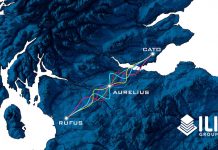Equinix’s David Hall says we must build data centres not only to power the immediate global data demands but to anticipate and meet sustainability demands of an increasingly connected world…
The internet now reaches an estimated 56% of the world’s population – a figure 9% higher than in January 2018. With the advent of 5G and promised download speeds of up to 10Gb/s, contributing to with a proliferation in connected devices, the levels of data being consumed are set to grow even further. In fact, by 2022, mobile data traffic alone is expected to reach 77.5 exabytes per month worldwide, growing at a compound annual rate of 46%.
This boom in data demand has coincided with increasing concern about corporate sustainability and a renewed impetus from companies in all sectors to reduce their carbon footprint – something that has been exacerbated since the signing of the Paris climate agreement in 2016. As a direct result, companies are asking how they can reduce their carbon footprint – a trend we expect will only gain more momentum as new, power-intensive technologies are developed and implemented.
With this in mind, it is important to consider the future of companies, and the cutting-edge technology required to continue powering the global digital boom as efficiently and sustainably as possible.
Measure it to manage it
With data now essentially being a company’s most valuable intellectual property, the sustainable processing, sharing and storing of it is of great importance. Companies like Equinix, that operate a global portfolio of data centres, must optimise supporting infrastructure to match digital demand to the highest degree possible. This means calculating the levels of power and cooling needed to support a site (and its customers).
Differing climates, varied weather patterns and possible natural disasters make it difficult to plan for optimal efficiency, but these challenges make an ideal use case for machine learning – an artificial intelligence (AI) approach that enables machines to independently learn, test and apply their knowledge.
Machine learning is particularly useful in this instance because it can examine huge swathes of data and find patterns within it. The ever-improving knowledge generated can then be used for the benefit of data centre optimisation, with minimum human input.
To support applications such as this, we developed IBX SmartView – a data centre infrastructure management (DCIM) tool that provides customers online access to real-time environmental and operating information relevant to the rack space they take up within our data centres. It monitors all the electrical and mechanical infrastructure within the data centre, and provides a platform in which Equinix can apply machine learning to continually update insights on the most efficient and reliable modes of operation.
The journey to PUE
Access to good data on power use provides the best opportunity to optimise data centres to run as efficiently and sustainably as possible. To assess progress in this area, we use power usage effectiveness (PUE) – an important industry metric for measuring the energy efficiency of a data centre’s infrastructure under normal operating conditions. PUE helps track power usage trends in an individual facility over time and measures the effects of different design and operational decisions.
As part of our commitment to improve the efficiency of our data centres, we recently adopted more stringent regional PUE design targets for new sites as well as major expansions. Our intention is to demonstrate industry best practice and lower our PUE through a mix of capital investments, improved design standards, best practices and operational discipline.
An example of this is in the initial phase of PUE optimisation models – we simulated a data centre and created a custom network architecture with engineered features using a neural network algorithm. This has since undergone a series of updates, and the latest version combines asset-based models within a network into a single data centre model.
As we continue to develop and create more advanced physics models, capable of making assumptions about individual elements of infrastructure such as IT workloads, external ambient conditions and other variables, we can gradually train the model to predict PUE increasingly effectively. Ultimately, when we reach a high level of confidence in the model, we can enable our platform to make real-time adjustment to our infrastructure without the need for human interaction at all.
Bringing the future forward
It is clear the data centre architectures that served us so well in the past, need updating to meet the demands of the future. Customers are increasingly concerned about sustainability. Indeed, in an independent global survey commissioned by Equinix of more than 2,450 IT decision-makers, 45% of respondents reported that their customers want them to demonstrate the sustainability of their IT infrastructure. And four in 10 (39%) said the carbon impact of their IT infrastructure is central to their IT strategy.
In our position as a global leader in the data centre and colocation market, it is our responsibility to continue to innovate and design the necessary solutions that will take us into the future. We are already seeing fruitful collaborations between major players in the sector, aimed at sharing learnings and solutions that will ensure digital progress is achieved as sustainably and seamlessly as possible.
As we have seen, both human design optimisation enabled by increased visibility, as well as cutting-edge use of machine learning, are playing a role in this future. However, we can still go further, and with anticipated global growth rates of the capacity to privately exchange data, via data centres, forecast to be 51% (according to the Global Interconnection Index Volume 3), the time for progress is now.
Whatever the means to achieve our goal, the challenge for data centres of the future is clear: we must build data centres not only to power the immediate global data demands but to anticipate and meet sustainability demands of an increasingly connected world.



